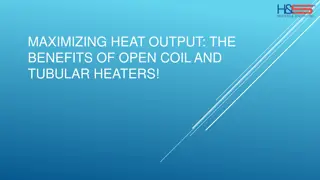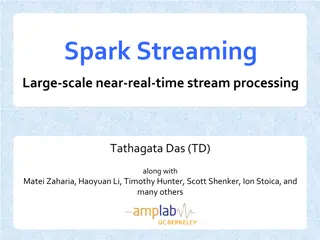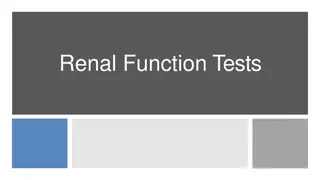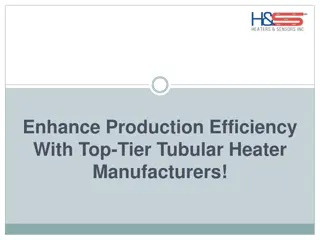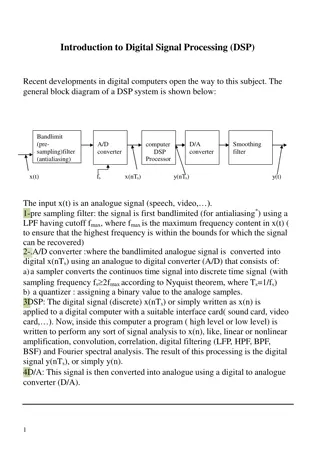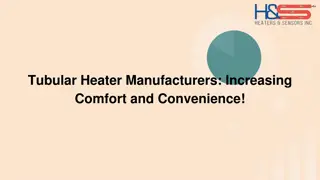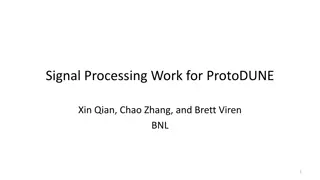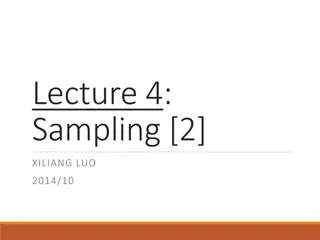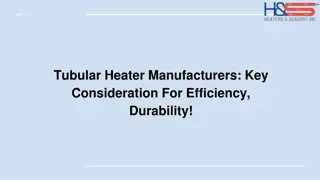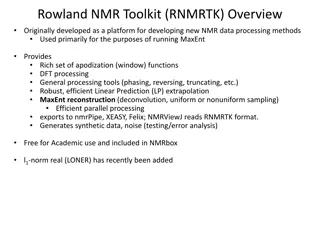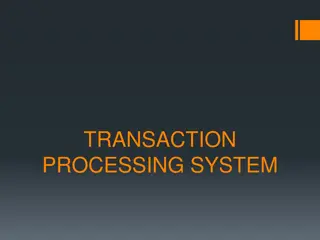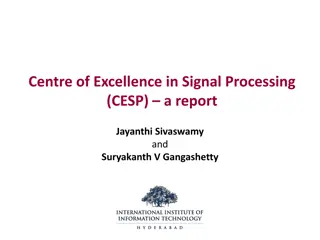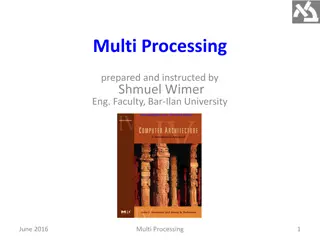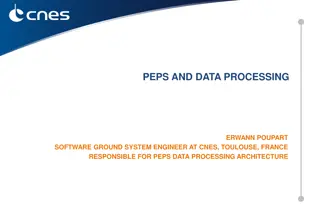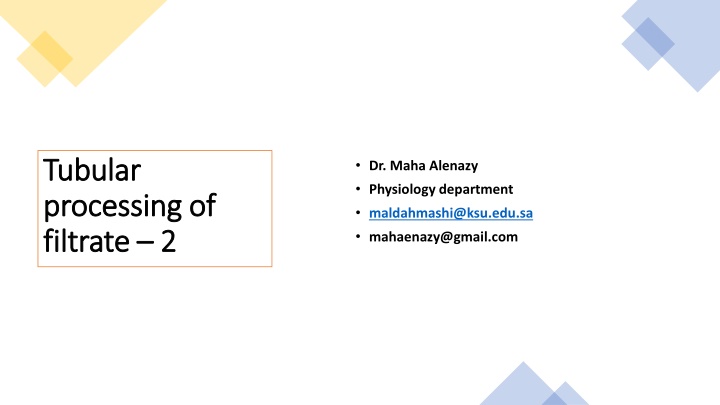
Tubular Processing in Kidneys: Loop of Henle and DCT
Explore the characteristics of the loop of Henle, distal convoluted tubule, and collecting ducts in kidney tubular processing for reabsorption and secretion. Learn about the role of aldosterone in Na+ reabsorption and K+ regulation. Dive into the intricate transport mechanisms in the nephron segments.
Download Presentation

Please find below an Image/Link to download the presentation.
The content on the website is provided AS IS for your information and personal use only. It may not be sold, licensed, or shared on other websites without obtaining consent from the author. If you encounter any issues during the download, it is possible that the publisher has removed the file from their server.
You are allowed to download the files provided on this website for personal or commercial use, subject to the condition that they are used lawfully. All files are the property of their respective owners.
The content on the website is provided AS IS for your information and personal use only. It may not be sold, licensed, or shared on other websites without obtaining consent from the author.
E N D
Presentation Transcript
Tubular Tubular processing of processing of filtrate filtrate 2 2 Dr. Maha Alenazy Physiology department maldahmashi@ksu.edu.sa mahaenazy@gmail.com
Objectives Objectives Identify and describe the characteristic of loop of Henle, distal convoluted tubule and collecting ducts for reabsorption and secretion Identify the site and describe the influence of aldosterone on reabsorption of Na+ in the late distal tubules. K+ regulation
Thin descending limb of loop of Henle is: highly permeable to water but moderately permeable to solutes Thick Ascending limb of loop of Henle is impermeable to water and solutes are reabsorbed Descending limb Ascending limb H+ 25% of Na+, Cl-, K+ are reabsorbed via Active transport of 1Na+, 2Cl-, and 1K+ Na+ Cl- K+ Ca+2 Mg+2 20% H2O Diffusion
Na+ reabsorption in TAL Basolateral Na+-K+ ATPase pumps 3Na+ out and 2 K+ inside the cell Na+ 3 Na+ Na+ Na+ Loop diuretics block NKCC2 2CL- ATPase NKCC2 Na+ K+ Na+ 2 K+ Na+ Na+ K+ Na+ This results in Na+ Na+ Na+ NHE3 Decrease Na+ concentration inside the cell H+ Mg+2 Ca+2 paracellular e.g. Lasix blocking 25% of filtered load (bcus triple transporter) Basolateral membrane Apical membrane This gradient favors passive entry of Na+ into the tubular cell across the apical membrane via NKCC2 along with CL- and K+
Distal convoluted tubule (DCT) and collecting duct (CD)
Transport across the distal tubule The late part of the DCT resembles cortical CD as it has two important kinds of cells: Principle cells which reabsorbs Na+ and H2O while secreting K+. Intercalated cells Type A which reabsorbs K+ and secretes H+ The early part of the DCT resembles the thick ascending loop of Henle. Its impermeable to water but pumps solutes actively So, its called the diluting segment. 5% Na+ is reabsorbed here It reabospbs 5% NaCL Early part late part Impermeable to urea Principle cells are controlled by Aldosterone In the late part of the DCT, H2O permeability is controlled by ADH It reabospbs 5% NaCL Intercalated cells Type A regulates acid- base balance
Transport mechanism in the early part of the distal convoluted tubule Basolateral Na+-K+ ATPase pumps 3Na+ out and 2 K+ inside the cell 3 Na+ Na+ Na+ ATPase NCC Na+ CL- Thiazide diuretics block NCC 2 K+ Na+ This results in Na+ Na+ Decrease Na+ concentration inside the cell Basolateral membrane Blocks transporter carrying 5% of filtered load Apical membrane This gradient favors passive entry of Na+ into the tubular cell across the apical membrane via NCC along with CL-
Late distal convoluted tubule and collecting duct + Aldosterone Na+ channel blockers Aldosteorne anatgonists (e.g. spironolactone) Principle cells use channels for Na+ and K+ specific to each which is different than other parts of the nephron that use carrier K+ sparing diuretics
Reabsorbs about 3% of filtered Na+ ADH controls permeability to H2O (ADH affects since late DCL) Permeable to urea Secretes H+ Medullary collecting duct
Summary of all Summary of all solutes solutes concentrations concentrations along the tubular along the tubular segments segments
Regulation of tubular reabsorption
Factors influencing tubular reabsorption regulations 1. physical forces that govern reabsorption 2. Hormonal and neuronal mechanism
Tubules can increase their absorption in response to increase tubular load glomerulo-tubular balance Physical factors regulating tubular reabsorption Oncotic pressure ( ) which pulls fluid in Hydrostatic pressure (P) which pushes fluid out
Physical forces that govern tubular reabsorption Pc is influenced by the following: o ABP o Aff and Eff arteriolar resistance reabsorptions Net absorptive force 10mmHG c is influenced by the following: o FF o Systemic plasma colloid osmotic pr. Pc Forces favoring reabsorption: c =32mmHg and PIF= 6. so total is 38 While Forces opposing reabsorption: Pc=13 and IF =15 . So total is 28 c P IF IF Forces favoring reabsorption = 38 > forces opposing it =28 Result: net absorptive force = 38-28 = 10mmHG
Hormonal regulation of tubular reabsorption Action Hormone Stimulated by - Stimulates Na+ and H2O reabsorption in PCT. - increases efferent vasoconstriction, so : a. it reduced peritubular capillary hydrostatic pressure increasing net tubular reabsorptive force b. Reduces renal blood flow and hence increases filtration fraction in the glomerulus which increases colloid pressure in the peritubular capillaries (this process increases tubular reabsorption) - It stimulated Aldosterone production stimulating Na+ reabsorption and K+ secretion Angiotensin II Renin, Low ABP, low BV, low NaCL, Aldosterone Angiotensin II P Cells to reabsorb Na+ and secrete K+ in DCT/CD H2O reabsorption in CD (AQP1) ADH Low ABP, low BV ANP Stretch sensors stimulated to high BV Blocks Na+/ H2O reabsorption in distal parts of nephron DCT and CD. It is opposite of aldosterone. Parathyroid hormone (PTH) Low Ca2 Lowers PO4- reabsorption while increasing Ca+2 reabsorption
HPO4- processing: PTH influence in HPO4- secretion 3Na+ PKA ATP phosphorylation 2K+ cAMP Adenyl Cyclase + Ca+2 PTH- secretion in PCT which is accompanied by increase Ca+2 reabsorption in the DCT and collecting dust as well as increase in Mg+ reabsorption in loop of Henle HPO4- - Na+ ATP + Gs Na+ HPO4- Na+ PTHR PTH HPO4- Na+ Na+ HPO4-
ADH (late part of DCT and CD) 3Na+ PKA phosphorylation ATP 2K+ cAMP Adenyl Cyclase + Na+ ATP Gs AQ P2 Na+ V2 H2O ADH AQ P2 Na+ H2O Na+ HPO4-
Potassium Potassium One of the most abundant cations in the body 98% in ICF and 2% in ECF K I > K o 150mEq/L >3.5-5mEq/L Importance of K+ Cell volume regulation Cell pH regulation Resting membrane potential Cardiac and neural activity
K+ homeostasis 2% 98% Body protection against hyperkalemia after meals Diet 50-200 mEq/day Absorption of 40mEq of K+ If K+ concentration increases in ECF to about 2mEq/L difference this is dangerous so we need to regulate and control! K+ output: 1) GI loss about 5- 10% 2) Renal excretion about 90-95%
Renal regulation of K+ concentration takes time so what does the body do to regulate this vital ion as quickly as possible? Solution Cellular shift
Cellular defense mechanism against K+ Cellular defense mechanism against K+ abnormalities abnormalities Cellular shift Conc of K+ is high in ECF--- shift K+ into the cell Conc of K+ is low in ECF shift K+ out of the cell Increased excretion in case of high K+ concentration and Decreased excretion in case of low K+ concentration Renal excretion
Factors that can shift K+ in and out of the cell Shift K+ out Shift K+ in Insulin Aldosterone - adrenergic stimulation Insulin deficiency Aldosterone deficiency - adrenergic blockers H+ K+ K+ H+ Acidosis H+ Alkalosis H Cell lysis Strenuous exercise ECF osmolarity
Physiologic factors affecting K+ distribution between ICF and ECF Aldosterone Insulin Epinephrine
Pathophysiologic factors affecting K+ Pathophysiologic factors affecting K+ distribution between ICF and ECF distribution between ICF and ECF Acid base disturbance Change in plasma osmolality Cell lysis Excercise How do these factors affect K+ distribution between ICF and ECF?
Renal K+ excretion
If K+ intake is low, only 1-3% of filtered K+ will be excreted About 65% reabsorbed by PCT About 25-30% reabsorbed by TAL 5-10% enters the distal portions of the nephron If K+ intake is normal to high, 10- 15% of filtered K+ will be excreted.
In the PCT, K+ reabsorption is a passive process .how? Water reabsorption is through paracellular route and drags K+ with it (solvent drag).
K+ handling by TAL: K+ handling by TAL: by Secondary active transport via the apical triple transporter (NKCC2)
K+ handling by the distal portions of the nephron High K+ intake, increased K+ secretion Principle cells Aldosterone + Na+ and water reabsorption & K+ secretion Low K+ intake, decreased K+ secretion -intercalated cells In K+ depletion, increased K+ readoption Secrete H+ and reabsorb K+
Factors regulating K+ secretion Factors regulating K+ secretion Factors stimulating K+ secretion: ECF K concentration Aldosterone tubular flow rate Factors decreasing K+ secretion: Acidosis H+


